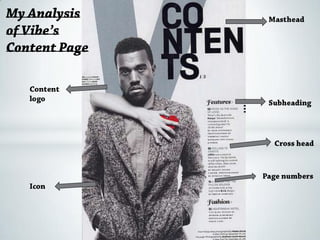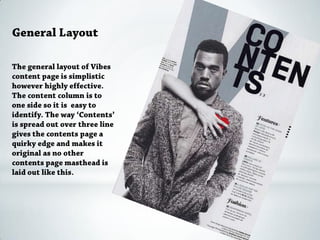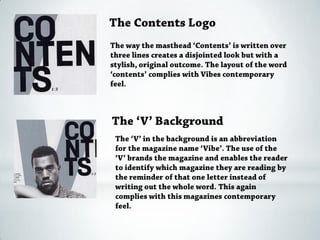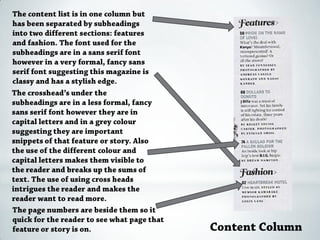1 of 6
Download to read offline






Ad
Recommended
Question 4
Question 4anitaasmedia
╠²
The document discusses how various media technologies were used at different stages of a project. YouTube was used for research on indie pop music videos. Adobe Photoshop was used to experiment with image manipulation techniques. Facebook was used to gather feedback on experimental images. Communication with group members was enabled through technology convergence. A DSLR camera and settings were used to take high quality photos. Adobe Premiere Pro was used to edit video, including adding effects like speed and dissolve transitions.Content Marketing Framework
Content Marketing FrameworkRachel Yu Dye
╠²
This document outlines a content marketing framework in 5 steps:
1) Strategy - Define personas, customer journeys, competitors' content, and a content sweet spot.
2) Goals - Set SMART goals for awareness, engagement, and other key performance indicators.
3) Content Creation - Generate ideas from research, choose appropriate formats, and establish guidelines.
4) Distribution - Share content through owned, earned, and bought media channels.
5) Measurement - Continuously optimize the process based on metrics in a long-term, cyclical approach.
Content marketing is presented as a strategic, ongoing technique to attract and engage customers through valuable, relevant content.Task 1 photograph_research[1]
Task 1 photograph_research[1]elleryanx
╠²
Photography is used extensively across several industries for advertising, promotion, and documentation purposes. In advertising, photography grabs attention and appeals to target audiences. Fashion photography promotes new lines in magazines. Music photography promotes artists through album covers, posters, and online. Sports photography is featured in magazines and used to promote athletes and teams. Photojournalism uses photography to anchor stories and allow readers to form their own opinions. Famous photographers like Peter Lindbergh, Andy Willsher, Bill Frakes, and Romano Cagnoni have advanced their respective fields through iconic images.Idea layout
Idea layoutanitaasmedia
╠²
The document discusses ideas for the layout and design of a music album digipak. For the front cover, the artist will make a heart shape with their hands around one eye. The inside left cover will feature a close-up photo of the artist wearing an animal mask to incorporate elements of the indie and pop genres. The CD design will use an ink blot of various colors to break convention. The back cover will show the artist lying on a heart-shaped cushion with the track list to the side.Question 2
Question 2anitaasmedia
╠²
The front cover features a male model in designer clothes to portray wealth and dominance, aligned with conventions of hip hop magazines. The full-frame shot reinforces the model's power through eye contact. The title "FRESH" and graffiti font also represent hip hop conventions. A faded car in the background symbolizes wealth. The contents page similarly presents a female model in designer clothes to look equally dominant rather than sexually available. Both images portray emerging views of gender equality.The history of music videos
The history of music videosanitaasmedia
╠²
Music videos have evolved over time from early experimental films responding to music in the 1930s to highly produced narratives and advertisements in today's era. Early videos featured lip syncing to promote songs and developing an artist's brand image. In the 1980s, MTV launched and videos challenged the traditional male gaze, with artists like Madonna giving women more control. Modern videos continue to both advertise the artist and song through narratives and cultural references, while sometimes challenging stereotypes around gender.CD covers
CD covers anitaasmedia
╠²
The document discusses the purposes and techniques used in CD covers. It analyzes covers for Marilyn Manson, Taylor Swift, Beyonce, and Eminem to demonstrate how covers communicate: 1) the artist's star image through visual codes like color, lighting, composition; 2) the musical genre through conventions of visuals and technical elements; and 3) a unique selling point through distinctive visual features. Analysis of individual covers shows how elements construct meanings that position the artist and genre.Music video analysis
Music video analysisanitaasmedia
╠²
The document analyzes the music videos for "We are Young" by Fun and "Foundation" by Kate Nash using Andrew Goodwin's framework. It finds that both videos demonstrate characteristics of the indie-pop genre through their narratives, camerawork, lighting, and lip syncing. The videos also have illustrative relationships between the lyrics and visuals, and edit the visuals to the beat of the music. Close-ups of the artists are included to promote identification with the audience. Gender is not portrayed through a male gaze. No intertextual references are present.Intuitive hiring can you trust your gut?
Intuitive hiring can you trust your gut?Melissa Pacheco
╠²
The document emphasizes the power of intuition in decision-making, particularly in the context of hiring and business success. It outlines a process for harnessing, listening to, testing, and acting on intuition to make better choices. Quotations from Steve Jobs and Albert Einstein underscore the value of intuitive thinking over pure intellect.Mood Board
Mood Boardelleryanx
╠²
The document discusses conventions of narrative-based music videos. Such videos typically match lyrics to corresponding visuals to engage audiences. Common settings include schools, streets, and clubs to appeal to wide audiences. Props like jewelry and cars, as well as costumes ranging from ordinary to extravagant, are also conventions used to relate to target viewers.Skpi isi
Skpi isiCyon D'javu
╠²
The document outlines the competencies and specific attitudes required of nurses and teachers/lecturers. It discusses knowledge mastery in areas like nursing theory, biomedical sciences, communication, research methods, and more. It also covers attitudes like being religious, upholding humanity, obeying laws, being accountable, and respecting privacy. The competencies and attitudes span clinical skills, management, education, research, and professional/ethical responsibilities.Intel Branding 1991-2013
Intel Branding 1991-2013Rachel Yu Dye
╠²
Moore's Law states that the number of transistors on an integrated circuit doubles approximately every two years. The document discusses the history of Intel from its founding in 1968 and creation of the first microprocessor in 1971 to becoming the number one manufacturer in the industry. It analyzes the microprocessor industry using Porter's Five Forces model and discusses Intel's strengths, weaknesses, opportunities, and threats. The changing technology environment with devices like PCs, smartphones, and tablets is also examined.XXL's Contents Page
XXL's Contents Page anitaasmedia
╠²
The general layout of XXL magazine's contents page is simplistic yet effective, containing more information than competitors. It labels the contents page "the A-side" rather than just "contents," making it unique. The features column is on the left with a main image on the right, in this case of rappers 50 Cent and Soulja Boy. Symbols and formatting are used strategically to guide readers' eyes and emphasize important details for the target young, hip-hop audience.Libel laws
Libel lawselleryanx
╠²
This document provides a brief overview of several UK laws related to communication and information, including privacy law which deals with personal information access, the Obscene Publications Act which governs what can be published, and the Human Rights Act of 1998.Cadbury beverages crush
Cadbury beverages crushRachel Yu Dye
╠²
This document summarizes Cadbury Beverages' plan to reposition the Crush orange soda brand in the US market. The key points are:
1) Cadbury wants to increase Crush's market share in the orange soda category from 14% to 13% by targeting teenagers and young adults with a "bold" advertising campaign positioning Crush as a "cool" drink.
2) The strategy involves increasing advertising spending to $9 million to build brand awareness, and ramping up promotions through retailers and bottlers to drive sales.
3) Financial projections estimate Crush can gain market share and volume through these efforts while maintaining profit margins of $0.10 per case.More Related Content
Viewers also liked (10)
CD covers
CD covers anitaasmedia
╠²
The document discusses the purposes and techniques used in CD covers. It analyzes covers for Marilyn Manson, Taylor Swift, Beyonce, and Eminem to demonstrate how covers communicate: 1) the artist's star image through visual codes like color, lighting, composition; 2) the musical genre through conventions of visuals and technical elements; and 3) a unique selling point through distinctive visual features. Analysis of individual covers shows how elements construct meanings that position the artist and genre.Music video analysis
Music video analysisanitaasmedia
╠²
The document analyzes the music videos for "We are Young" by Fun and "Foundation" by Kate Nash using Andrew Goodwin's framework. It finds that both videos demonstrate characteristics of the indie-pop genre through their narratives, camerawork, lighting, and lip syncing. The videos also have illustrative relationships between the lyrics and visuals, and edit the visuals to the beat of the music. Close-ups of the artists are included to promote identification with the audience. Gender is not portrayed through a male gaze. No intertextual references are present.Intuitive hiring can you trust your gut?
Intuitive hiring can you trust your gut?Melissa Pacheco
╠²
The document emphasizes the power of intuition in decision-making, particularly in the context of hiring and business success. It outlines a process for harnessing, listening to, testing, and acting on intuition to make better choices. Quotations from Steve Jobs and Albert Einstein underscore the value of intuitive thinking over pure intellect.Mood Board
Mood Boardelleryanx
╠²
The document discusses conventions of narrative-based music videos. Such videos typically match lyrics to corresponding visuals to engage audiences. Common settings include schools, streets, and clubs to appeal to wide audiences. Props like jewelry and cars, as well as costumes ranging from ordinary to extravagant, are also conventions used to relate to target viewers.Skpi isi
Skpi isiCyon D'javu
╠²
The document outlines the competencies and specific attitudes required of nurses and teachers/lecturers. It discusses knowledge mastery in areas like nursing theory, biomedical sciences, communication, research methods, and more. It also covers attitudes like being religious, upholding humanity, obeying laws, being accountable, and respecting privacy. The competencies and attitudes span clinical skills, management, education, research, and professional/ethical responsibilities.Intel Branding 1991-2013
Intel Branding 1991-2013Rachel Yu Dye
╠²
Moore's Law states that the number of transistors on an integrated circuit doubles approximately every two years. The document discusses the history of Intel from its founding in 1968 and creation of the first microprocessor in 1971 to becoming the number one manufacturer in the industry. It analyzes the microprocessor industry using Porter's Five Forces model and discusses Intel's strengths, weaknesses, opportunities, and threats. The changing technology environment with devices like PCs, smartphones, and tablets is also examined.XXL's Contents Page
XXL's Contents Page anitaasmedia
╠²
The general layout of XXL magazine's contents page is simplistic yet effective, containing more information than competitors. It labels the contents page "the A-side" rather than just "contents," making it unique. The features column is on the left with a main image on the right, in this case of rappers 50 Cent and Soulja Boy. Symbols and formatting are used strategically to guide readers' eyes and emphasize important details for the target young, hip-hop audience.Libel laws
Libel lawselleryanx
╠²
This document provides a brief overview of several UK laws related to communication and information, including privacy law which deals with personal information access, the Obscene Publications Act which governs what can be published, and the Human Rights Act of 1998.Cadbury beverages crush
Cadbury beverages crushRachel Yu Dye
╠²
This document summarizes Cadbury Beverages' plan to reposition the Crush orange soda brand in the US market. The key points are:
1) Cadbury wants to increase Crush's market share in the orange soda category from 14% to 13% by targeting teenagers and young adults with a "bold" advertising campaign positioning Crush as a "cool" drink.
2) The strategy involves increasing advertising spending to $9 million to build brand awareness, and ramping up promotions through retailers and bottlers to drive sales.
3) Financial projections estimate Crush can gain market share and volume through these efforts while maintaining profit margins of $0.10 per case.